Best of the best: 10 top high-performance computing upgrades on test
High-end PC processors and motherboards rated
1. Asus P9X79 Pro
Price: £205
Chipset: X79
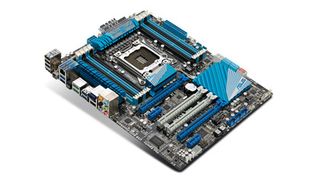
For many Intel's top-rung X79 platform will be right at the ragged edge of what your wallet will tolerate, so every little thing will help to make the numbers add up. That's where the Asus P9X79 Pro comes in.
It's not the cheapest choice of motherboard you can buy based on the Intel X79 chipset, but the extra £30 over the likes of the Gigabyte X79-UD3 buys you a number of attractive features.
The most conspicuous feature is the support for solid state drive caching. In an ideal world, you'd simply plug in the biggest SSD you could find and enjoy some serious solid state speed. The problem is, large SSDs come with equally hefty price tags. The ability to pair a smaller SSD with a large conventional hard disk, therefore, makes for a very sensible compromise between storage capacity and cost aiming for maximum bang-per-buck. We're still years away from solid state drives that are both large and affordable.
The P9X79 Pro also benefits from Asus's graphical UEFI BIOS, which might just be the best in the business. Apart from the snazzy looking and responsive interface, you get screenshot capability, easy updates via USB and an auto-overclocking option that ramped our Intel Core i7 3960X processor up to 4.3GHz. The latter is a function also available via the physical TPU switch, so you don't even need to jump into the BIOS.
Read the full Asus P9X79 Pro review
2. Gigabyte X79-UD3
Price: £175
Chipset: X79
Get daily insight, inspiration and deals in your inbox
Sign up for breaking news, reviews, opinion, top tech deals, and more.
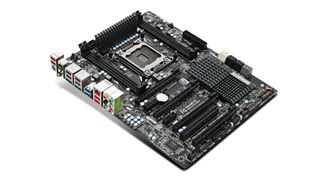
Plotting a performance PC? Then snag a high-end motherboard, right? That's the conventional wisdom directly challenged by the new Gigabyte X79-UD3.
Of course, any board based on Intel's X79 chipset hardly rates as a budget item. At £175, the Gigabyte X79-UD3 ain't exactly cheap, but it is within a fiver of the cheapest X79 motherboards on the market. Everything, therefore, is relative.
Consequently, the Gigabyte X79-UD3 is flagrantly frills-free, but with so many features now finding their way onto the CPU die itself - including the memory controller and PCI Express bus - you could argue that motherboards in general are less critical.
Gigabyte's task is to deliver quality and performance where it matters, without going overboard on the corner-cutting compared with more expensive X79 models such as the Asus P9X79 Pro and MSI X79A-GD65 8D.
Ultimately, the verdict on the Gigabyte X79-UD3 will come down to what it does and doesn't do. What it undoubtedly does is deliver performance pretty much indistinguishable from any other X79 board in the known universe. These days, we're accustomed to pretty consistent performance across motherboards sharing the same chipset. The X79-UD3 is no exception to this.
Read the full Gigabyte X79-UD3 review
3. MSI X79A-GD65 8D
Price: £225
Chipset: X79
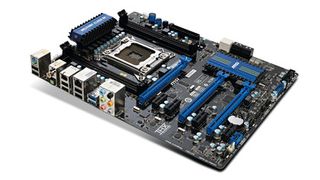
Can there be such a thing as too much system memory? In the context of the new MSI X79A-GD65 8D motherboard that's the first question that leaps to mind.
As an X79 board compatible with the latest Intel Core i7 processors for the LGA2011 socket, it forms part of the highest performing PC platform on Earth, but you still have to wonder whether support for 128GB of DDR3 memory split over eight DIMM slots is really rational. Sure, for server PCs running multiple virtualised operating systems and a whole hill of applications, that much memory is a boon. But for desktop PCs, even those running heavy duty content creations apps, 8GB or 16GB is usually plenty.
In its fisticuffs with the Gigabyte X79-UD3 and Asus's P9X79 Pro, the MSI X79A-GD65 8D will need a few more tricks up its sleeve. Moreover, the X79A-GD65 8D costs that little bit more than the P9X79 Pro, which in turn is priced at a marginal premium to the X79-UD3.
Is it a case of incremental upgrades all along the line, or has MSI done enough to put this X79-based board in another class altogether? Maybe that old MSI favourite, the OC Genie button, can make the difference?
Read the full MSI X79A-GD65 8D review
4. Intel Xeon 2687W
Price: £1400
Socket: LGA 2,011
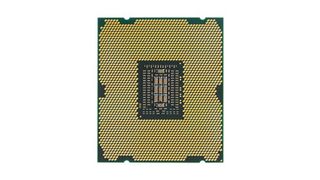
Say hello to the real Sandy Bridge E, for it is this Xeon processor that truly reveals what Intel's ultimate 32nm technology is capable of. Up to a point, anyway.
Yes, the Core i7 3960X is an impostor - a cut-down shyster of a chip. Back when Intel launched the six-core 3960X, we were told that the decision to switch off two cores in the shiny new eight-core Sandy Bridge E die was all part of a balancing act. Intel had weighed up the conflict between clockspeed and cores, and decided that the best overall compromise was six cores at 3.3GHz with a little Turbo action on top.
Running eight cores would have meant a significant drop in clock speed and therefore compromising per-core performance. At the time, frankly, we weren't buying it. Even if opening out all eight cores would mean a big drop in the clocks with all cores heavily loaded, surely the whole point of Intel's Turbo technology is that the chip could still clock up when only a handful of cores were doing the heavy lifting?
Well, now the fastest eight-core Xeon iteration of precisely the same Sandy Bridge E processor die has arrived and the truth is out. The Xeon 2687W is rated at 3.1GHz, just 200MHz slower than the six-core Core i7 3960X. Thus, the 3960X runs just six per cent faster while the Xeon 2687W has 33 per cent more cores.
Read the full Intel Xeon 2687W review
5. Asus P8Z68-V LX
Price: £75
Chipset: Z68
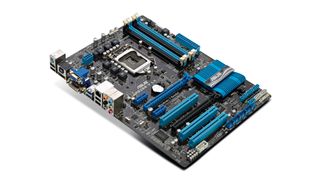
A budget board with a premium chipset - is that the most effective combination for achieving maximum bang-for-buck? If that is so, then Asus P8Z68-V LX is positioned perfectly.
It sells for as little as £75 but it packs Intel's Z68 chipset. Okay, that means at best you're stuck with mainstream LGA 1155 processors and a quad-core cap, rather than the six and eight-core (the latter in the form of Xeon CPUs) beasts available for the monstrous LGA 2011 bucket of pins.
But as LGA 1155 chipsets go, the Z68 is easily the pick of the bunch. You get full access to overclocking features, the ability to run a discrete graphics card and still use Intel's QuickSync video transcode engine and some nice little extras, including Intel's SmartResponse SSD caching technology.
The prospect of a Z68 board for just £75, then, is a question begging for an answer. Asus may have managed to to squeeze in a few of our own particular treats. But what has been chopped from the P8Z68-V LX?
Read the full Asus P8Z68-V LX review
6. Gigabyte GA-Z68XP-UD3-ISSD
Price: £155
Chipset: Z68
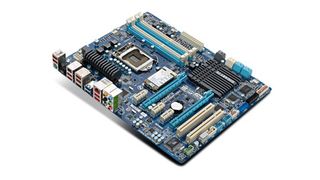
Double your pleasure. Double your fun. With Gigabyte's double-priced Z68 board. Deftly dropping the DoubleMint gum ditty into a motherboard review may be beyond our wits, but the real problem is whether Gigabyte has a shot at justifying the fact that the tediously-monikered GA-Z68XPUD3- iSSD costs twice as much as Asus's P8Z68-V LX.
One thing's for sure, Gigabyte isn't going to get the job done based on raw performance. There's virtually nothing in it, and even when a small differential is detectable, it isn't always in Gigabyte's favour. We couldn't discern a significant difference during overclocking either. Both boards extracted the same 4.5GHz from our Core i7 2700K test chip.
Gigabyte is, therefore, left with one remaining hope: ye olde feature set. Out of the box, things don't look great. We're pretty partial to hardware power, reset and Clear-CMOS switches - it's the least you'd expect from a £150-plus board. We can't help noticing the lack of DVI or eSATA ports on the back panel, too.
Dig a little deeper though, and you begin to identify where the extra cash is going. For starters, Gigabyte gives you proper multi-GPU support with one 16-lane socket and one eight-lane. Both Nvidia's SLI and AMD's CrossFireX are supported.
Read the full Gigabyte GA-Z68XP-UD3-ISSD review
7. Intel Core i7 2700K
Price: £255
Socket: LGA 1155
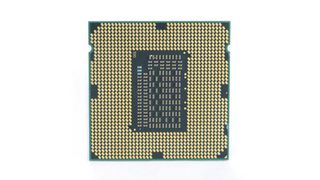
This is awfully familiar - Intel's Core i7 2700K is saddled with Intel's mainstream LGA 1155 socket. In theory, the exciting stuff all happens on LGA 2011.
What's more, in a gaming context, we've never jived with the 2700K and its dual threads per core. That's because games don't scale enormously well across multiple threads, and the Core i5 2500K has all the per-core, single-threaded oomph of its much more expensive Core i7 cousins, be they in LGA 1155 or LGA 2011 format.
It's all the gaming chip you'll ever need. But is the 2700K back in the hunt if you shift the context to high performance computing? It's certainly a much more cost effective option than the LGA 2011 alternatives.
You can pick up a very respectable LGA 1155 motherboard for just £75, whereas a basic LGA 2011 item is more like £175. Then there's the chip cost itself. Even at £255, you're looking at half the cost of the cheapest six-core i7 model, much less the preposterously pricey Xeon eight-core.
Read the full Intel Core i7 2700K review
8. Sapphire Pure Black 990FX
Price: £135
Chipset: 990FX
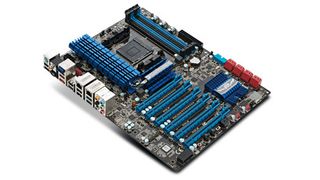
Your eyes do not deceive you. Do not adjust your set. The Sapphire PURE Black 990FX motherboard really does have six PCI Express x16 slots.
That doesn't mean, of course, that you can run six graphics cards in parallel. Not in the conventional multi-GPU sense, since the maximum number of cards supported by AMD's CrossFireX tech is four, and SLI isn't on the menu at all.
Still, if running a veritable army of displays is your bag, the sextet of slots offers plenty of potential. More to the point, it means you have endless options in terms of how you arrange your add-in boards, though the fact that the final two are only x4 electric does limit your options somewhat.
The lack of PCI connectivity of any kind also rules out any dusty old legacy cards you might be thinking about bunging in.
Expansion aside, the PURE Black 990FX is arguably up against it from the off. That's because it's an AMD AM3+ board, and neither the new AMD FX nor ye olde AMD Phenom II chips really threaten the top of the performance table. If we're honest, they're not exactly terrorising the mid-range either.
Read the full Sapphire Pure Black 990FX review
9. AMD Phenom II X6 1090T Black Edition
Price: £110
Socket: AM3

AMD's shiny new Bulldozer FX processors have been released into the wild for some time now, so you might be wondering what this crusty old Phenom II processor is doing sullying this showcase of white-hot, high performance computing platforms.
Well, it all depends on pricing and product availability. We're not sure if AMD is still cranking out the Thuban processor dies that form the basis of the Phenom II X6 1090T Black Edition, though we believe that to be the case, if only for manufacturing server processors.
Read the full AMD Phenom II X6 1090T Black Edition review
10. AMD FX 8150
Price: £196
Socket: AM3+
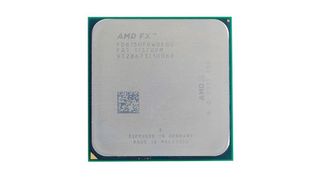
Sadly, in what appears to be an increasing, and worrying, tradition for the 'other' CPU manufacturer, the launch of the AMD FX processor was something of a debacle. AMD's much feted new eight-threaded modular architecture delivered in neither in real-world performance nor efficiency.
In fact, it was so underwhelming, it left us with the nagging suspicion that an eight-core Phenom II would actually be a better bet. That's quite a disturbing notion, given the general consensus that the Phenom II's micro-architecture was no longer competitive.
Things went from bad to bizarre when it emerged that the FX's transistor count was not actually two billion, as originally claimed, but closer to 1.2 billion.
Technology and cars. Increasingly the twain shall meet. Which is handy, because Jeremy (Twitter) is addicted to both. Long-time tech journalist, former editor of iCar magazine and incumbent car guru for T3 magazine, Jeremy reckons in-car technology is about to go thermonuclear. No, not exploding cars. That would be silly. And dangerous. But rather an explosive period of unprecedented innovation. Enjoy the ride.











